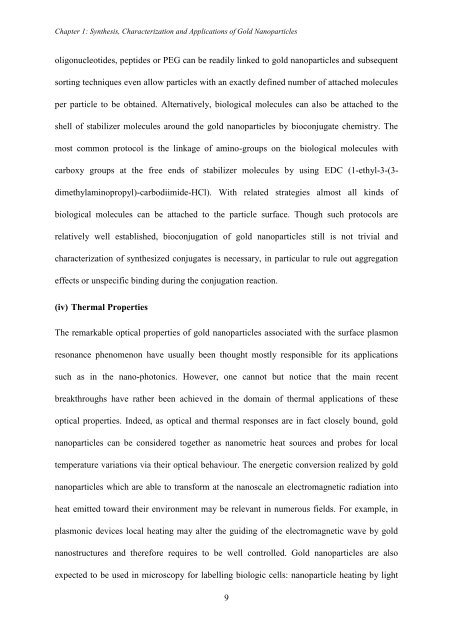PHYS01200704032 Debes Ray - Homi Bhabha National Institute
PHYS01200704032 Debes Ray - Homi Bhabha National Institute
PHYS01200704032 Debes Ray - Homi Bhabha National Institute
You also want an ePaper? Increase the reach of your titles
YUMPU automatically turns print PDFs into web optimized ePapers that Google loves.
Chapter 1: Synthesis, Characterization and Applications of Gold Nanoparticles<br />
oligonucleotides, peptides or PEG can be readily linked to gold nanoparticles and subsequent<br />
sorting techniques even allow particles with an exactly defined number of attached molecules<br />
per particle to be obtained. Alternatively, biological molecules can also be attached to the<br />
shell of stabilizer molecules around the gold nanoparticles by bioconjugate chemistry. The<br />
most common protocol is the linkage of amino-groups on the biological molecules with<br />
carboxy groups at the free ends of stabilizer molecules by using EDC (1-ethyl-3-(3-<br />
dimethylaminopropyl)-carbodiimide-HCl). With related strategies almost all kinds of<br />
biological molecules can be attached to the particle surface. Though such protocols are<br />
relatively well established, bioconjugation of gold nanoparticles still is not trivial and<br />
characterization of synthesized conjugates is necessary, in particular to rule out aggregation<br />
effects or unspecific binding during the conjugation reaction.<br />
(iv) Thermal Properties<br />
The remarkable optical properties of gold nanoparticles associated with the surface plasmon<br />
resonance phenomenon have usually been thought mostly responsible for its applications<br />
such as in the nano-photonics. However, one cannot but notice that the main recent<br />
breakthroughs have rather been achieved in the domain of thermal applications of these<br />
optical properties. Indeed, as optical and thermal responses are in fact closely bound, gold<br />
nanoparticles can be considered together as nanometric heat sources and probes for local<br />
temperature variations via their optical behaviour. The energetic conversion realized by gold<br />
nanoparticles which are able to transform at the nanoscale an electromagnetic radiation into<br />
heat emitted toward their environment may be relevant in numerous fields. For example, in<br />
plasmonic devices local heating may alter the guiding of the electromagnetic wave by gold<br />
nanostructures and therefore requires to be well controlled. Gold nanoparticles are also<br />
expected to be used in microscopy for labelling biologic cells: nanoparticle heating by light<br />
9

















